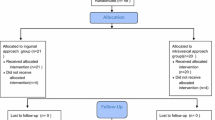Abstract
Purpose
In male patients, the pudendal block was applied only in rare cases as a therapy of neuralgia of the pudendal nerve. We compared pudendal nerve block (NPB) and combined spinal-epidural anesthesia (CSE) in order to perform a pain-free high-dose-rate (HDR) brachytherapy in a former pilot study in 2010. Regarding this background, in the present study, we only performed the bilateral perineal infiltration of the pudendal nerve.
Methods
In 25 patients (71.8 ± 4.18 years) suffering from a high-risk prostate carcinoma, we performed the HDR-brachytherapy with the NPB. The perioperative compatibility, the subjective feeling (German school marks principle 1–6), subjective pain (VAS 1–10) and the early postoperative course (mobility, complications) were examined.
Results
All patients preferred the NPB. There was no change of anesthesia form necessary. The expense time of NPB was 10.68 ± 2.34 min. The hollow needles (mean 24, range 13–27) for the HDR-brachytherapy remained on average 79.92 ± 12.41 min. During and postoperative, pain feeling was between 1.4 ± 1.08 and 1.08 ± 1.00. A transurethral 22 French Foley catheter was left in place for 6 h. All patients felt the bladder catheter as annoying, but they considered postoperative mobility as more important as complete lack of pain. The subjective feeling was described as 2.28 ± 0.74. Any side effects or complications did not appear.
Conclusions
Bilateral NPB is a safe and effective analgesic option in HDR-brachytherapy and can replace CSE. It offers the advantage of almost no impaired mobility of the patient and can be performed by the urologist himself. Using transrectal ultrasound guidance, the method can be learned quickly.




Similar content being viewed by others
References
Schenck M, Krause K, Schwandtner R, Haase I, Fluehs D, Friedrich J, Jaeger T, Boergermann C, Ruebben H, Stuschke M (2006) High-dose rate brachytherapy for high-risk prostate cancer. Urologe A 45(6):715–716, 718–722. doi:10.1007/s00120-006-1083-x
Schenck M, Kliner SJ, Achilles M, Schenck C, Berkovic K, Ruebben H, Stuschke M (2010) Pudendal block or combined spinal-epidural anaesthesia in high-dose-rate brachytherapy for prostate carcinoma? Aktuelle Urol 41(1):43–51. doi:10.1055/s-0029-1224722
Scudamore JH, Yates MJ (1966) Pudendal block—a misnomer? Lancet 1(7427):23–24
Niesel HC, Eilingsfeld T (1994) The extent of spinal anesthesia depends on the amount of he injected local anesthetic–fact or fiction? Anasthesiol Intensivmed Notfallmed Schmerzther 29(7):427–429
Ohel G, Gonen R, Vaida S, Barak S, Gaitini L (2006) Early versus late initiation of epidural analgesia in labor: does it increase the risk of cesarean section? A randomized trial. Am J Obstet Gynecol 194(3):600–605. doi:10.1016/j.ajog.2005.10.821
Hagen NA (1993) Sharp, shooting neuropathic pain in the rectum or genitals: pudendal neuralgia. J Pain Symptom Manage 8(7):496–501
Labat JJ, Robert R, Bensignor M, Buzelin JM (1990) Neuralgia of the pudendal nerve. Anatomo-clinical considerations and therapeutical approach. J Urol (Paris) 96(5):239–244
Robert R, Prat-Pradal D, Labat JJ, Bensignor M, Raoul S, Rebai R, Leborgne J (1998) Anatomic basis of chronic perineal pain: role of the pudendal nerve. Surg Radiol Anat 20(2):93–98
Birch BR, Gelister JS, Parker CJ, Chave H, Miller RA (1991) Transurethral resection of prostate under sedation and local anesthesia (sedoanalgesia). Experience in 100 patients. Urology 38(2):113–118
Birch BR, Miller RA (1991) Birch-Miller electrotest needle: aid to local anesthetic endoscopic surgery. Urology 38(1):64–65
Chander J, Gupta U, Mehra R, Ramteke VK (2000) Safety and efficacy of transurethral resection of the prostate under sedoanalgesia. BJU Int 86(3):220–222
Akalin Z, Mungan NA, Basar H, Aydoganli L, Cengiz T (1998) Transurethral resection of the prostate and laser prostatectomy under local anesthesia. Eur Urol 33(2):202–205
Rodrigues AO, Machado MT, Wroclawski ER (2002) Prostate innervation and local anesthesia in prostate procedures. Rev Hosp Clin Fac Med Sao Paulo 57(6):287–292
Amarenco G, Savatovsky I, Budet C, Perrigot M (1989) Perineal neuralgia and Alcock’s canal syndrome. Ann Urol (Paris) 23(6):488–492
Robert R, Labat JJ, Bensignor M, Glemain P, Deschamps C, Raoul S, Hamel O (2005) Decompression and transposition of the pudendal nerve in pudendal neuralgia: a randomized controlled trial and long-term evaluation. Eur Urol 47(3):403–408. doi:10.1016/j.eururo.2004.09.003
Mauillon J, Thoumas D, Leroi AM, Freger P, Michot F, Denis P (1999) Results of pudendal nerve neurolysis-transposition in twelve patients suffering from pudendal neuralgia. Dis Colon Rectum 42(2):186–192
Shafik A, el-Sherif M, Youssef A, Olfat ES (1995) Surgical anatomy of the pudendal nerve and its clinical implications. Clin Anat 8(2):110–115. doi:10.1002/ca.980080205
Peng PW, Tumber PS (2008) Ultrasound-guided interventional procedures for patients with chronic pelvic pain—a description of techniques and review of literature. Pain Physician 11(2):215–224
Thoumas D, Leroi AM, Mauillon J, Muller JM, Benozio M, Denis P, Freger P (1999) Pudendal neuralgia: CT-guided pudendal nerve block technique. Abdom Imaging 24(3):309–312
Gruber H, Kovacs P, Piegger J, Brenner E (2001) New, simple, ultrasound-guided infiltration of the pudendal nerve: topographic basics. Dis Colon Rectum 44(9):1376–1380
Kovacs P, Gruber H, Piegger J, Bodner G (2001) New, simple, ultrasound-guided infiltration of the pudendal nerve: ultrasonographic technique. Dis Colon Rectum 44(9):1381–1385
Gerheuser F, Roth A (2007) Epidural anesthesia. Anaesthesist 56(5):499–523; quiz 524–496. doi:10.1007/s00101-007-1181-1
Conflict of interest
None of the authors has direct or indirect financial incentive associated with publishing the article.
Author information
Authors and Affiliations
Corresponding author
Rights and permissions
About this article
Cite this article
Schenck, M., Schenck, C., Rübben, H. et al. Pudendal nerve block in HDR-brachytherapy patients: do we really need general or regional anesthesia?. World J Urol 31, 417–421 (2013). https://doi.org/10.1007/s00345-012-0987-x
Received:
Accepted:
Published:
Issue Date:
DOI: https://doi.org/10.1007/s00345-012-0987-x




